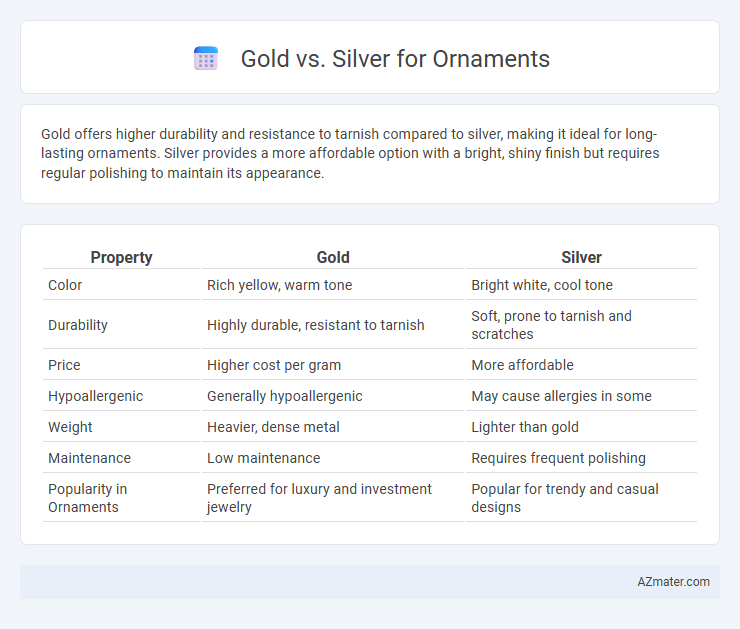Gold offers higher durability and resistance to tarnish compared to silver, making it ideal for long-lasting ornaments. Silver provides a more affordable option with a bright, shiny finish but requires regular polishing to maintain its appearance.
Table of Comparison
| Property | Gold | Silver |
|---|---|---|
| Color | Rich yellow, warm tone | Bright white, cool tone |
| Durability | Highly durable, resistant to tarnish | Soft, prone to tarnish and scratches |
| Price | Higher cost per gram | More affordable |
| Hypoallergenic | Generally hypoallergenic | May cause allergies in some |
| Weight | Heavier, dense metal | Lighter than gold |
| Maintenance | Low maintenance | Requires frequent polishing |
| Popularity in Ornaments | Preferred for luxury and investment jewelry | Popular for trendy and casual designs |
Introduction: Gold vs Silver in Ornamentation
Gold and silver each offer unique qualities that enhance ornamentation, with gold prized for its luxurious yellow hue and resistance to tarnish, making it ideal for timeless, high-value jewelry. Silver's bright, reflective finish provides a versatile and affordable alternative, popular for contemporary and intricate designs. Durability, hypoallergenic properties, and cultural significance also influence preferences between gold and silver in ornament crafting.
Historical Significance of Gold and Silver Ornaments
Gold ornaments have symbolized wealth and power across civilizations, from Ancient Egypt's pharaohs to the Roman Empire's elite, due to gold's rarity and resistance to tarnish. Silver ornaments, valued for their affordability and lustrous appeal, have historically been linked to cultural rituals and everyday adornment in societies such as the Aztecs and medieval Europe. The enduring legacy of gold and silver in ornamentation reflects distinct social, economic, and spiritual roles that have shaped human history.
Popularity Trends: Gold vs Silver Jewelry
Gold jewelry continues to dominate the market with its timeless appeal and higher perceived value, driving consistently strong sales across global luxury segments. Silver jewelry is gaining popularity among younger consumers for its affordability and versatility, often seen in fashion-forward and everyday styles. Market data indicates a steady rise in silver purchases, particularly in regions with emerging middle-class demographics, reflecting shifting preferences alongside gold's enduring prestige.
Physical Properties: Durability and Luster Comparison
Gold exhibits superior durability due to its resistance to tarnish and corrosion, making it ideal for long-lasting ornaments, while silver is more prone to tarnishing and requires regular polishing to maintain its shine. In terms of luster, silver has a brighter, more reflective surface that offers a striking, mirror-like finish, contrasting with gold's warmer, softer glow that adds a classic elegance to jewelry. The density of gold also contributes to its heavier, more substantial feel, which many consumers associate with higher quality and luxury.
Skin Tone Compatibility: Choosing Gold or Silver
Gold jewelry enhances warm skin tones with its rich, yellow hues, complementing olive, tan, and darker complexions by adding a radiant glow. Silver jewelry tends to flatter cool skin tones, such as fair or pinkish complexions, by providing a crisp contrast that highlights natural undertones. Selecting between gold and silver for ornaments depends on matching metal color with individual undertones, ensuring a harmonious and flattering appearance.
Cost Analysis: Affordability and Investment Value
Gold ornaments generally command higher prices due to their intrinsic value and market demand, making them a more substantial investment but less affordable for everyday purchases. Silver offers a cost-effective alternative with lower upfront costs, appealing to budget-conscious consumers seeking stylish jewelry without significant financial commitment. While gold retains value better over time as a hedge against inflation, silver's market volatility can lead to fluctuating investment returns.
Maintenance and Care for Gold and Silver Ornaments
Gold ornaments require minimal maintenance due to their resistance to tarnish and corrosion, needing only occasional polishing with a soft cloth to maintain shine. Silver ornaments demand more frequent cleaning and careful storage to prevent tarnish, often requiring a silver polishing cloth or special cleaning solutions. Proper storage in airtight containers and avoiding exposure to moisture and chemicals prolong the lifespan and appearance of both gold and silver jewelry.
Design Versatility and Style Preferences
Gold offers timeless elegance and warmth, making it ideal for classic and luxurious ornament designs, while silver's cool tones provide a modern and sleek aesthetic favored in contemporary styles. The malleability of gold allows intricate craftsmanship and detailed patterns that appeal to traditional jewelry lovers, whereas silver's affordability and versatility enable bold, trendy designs popular among younger audiences. Consumer preferences vary, with gold symbolizing status and permanence, while silver often represents affordability and everyday wearability in fashion choices.
Allergenicity and Comfort Factors
Gold jewelry, especially high-karat variants like 18K or 24K, is hypoallergenic and less likely to cause skin irritation compared to silver, which may contain nickel or other alloys that trigger allergic reactions. Silver, particularly sterling silver (92.5% pure), can tarnish and lead to discomfort for sensitive skin when exposed to moisture and air, whereas gold maintains its luster and comfort over prolonged wear. The weight of gold provides a substantial feel that many find comfortable, but silver's lighter nature appeals to those preferring less bulk in their ornaments.
Final Verdict: Which Metal Suits You Best?
Gold offers a timeless, warm hue that complements a variety of skin tones and often symbolizes luxury and status, making it ideal for formal or traditional ornaments. Silver, with its sleek, cool appearance, suits modern and minimalist styles, providing versatility for everyday wear and a budget-friendly option. Choosing between gold and silver depends on personal style preferences, skin undertone compatibility, and the occasion where the ornament will be worn.

Infographic: Gold vs Silver for Ornament
 azmater.com
azmater.com